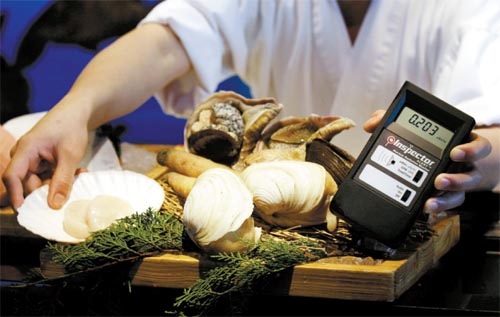Gov’t screening all food from Japan

Imported seafood from Japan is screened for radiation by a chef at a Japanese restaurant in Hong Kong yesterday. The World Health Organization has urged Japan to adopt stricter measures to reassure the public. [AP/YONHAP]
Korea will screen all food products originating from or shipped through Japan, as the crisis at the Fukushima Daiichi nuclear power plant continues.
The Korea Food and Drug Administration said yesterday that it would expand its screening process to cover imported food products that pass through Japan on their way to Korea, in addition to Japanese-made products. The KFDA said screening would be done on dried, chilled or frozen agricultural products, processed foods, food additives and health products.
Radiation testing began on March 14 for fresh produce from Japan.
The KFDA initially said it would be screening for cesium 134 and cesium 137, but added iodine 131 to the list on Monday. All radioactive isotopes can affect human cells and cause health problems in the case of prolonged exposure.
“The expansion of the screening process was decided after it was announced that radiation levels were detected in Japan’s agricultural products and tap water,” the KFDA said. “It is a preventive measure to strengthen screening of imported products from Japan and other countries.” Similar measures are being taken in several European countries and the United States.
According to the KFDA, over 40 million kilograms (44,092 tons) of processed foods, 12 million kilograms of food additives, 137,172 kilograms of agricultural products and 413,171 kilograms of health products were imported from Japan in 2010.
The KFDA’s decision came after radioactivity was detected in Japanese food products. The agency found 54,000 becquerel per kilogram of spinach grown in Hitachi, Ibaraki Prefecture, more than 100 kilometers (62 miles) south of the crippled Fukushima Daiichi nuclear plant. That level of radiation is 27 times the limit set by the Japanese government under its food sanitation laws.
High iodine levels were also found in spinach grown in Kitaibaraki, Ibaraki Prefecture, at 24,000 becquerel per kilogram. The same spinach was also found to have cesium levels of 690 becquerel per kilogram, 190 times over the legal limit. Ibaraki Gov. Masaru Hashimoto ordered the halt of spinach shipments from the prefecture, but said the produce posed no risk to humans.
The Japanese government also announced Sunday that iodine-contaminated milk had been found in Fukushima Prefecture and would be taken off the market.
Because of contamination fears, imports of Japanese aquatic and agricultural products have fallen, according to the Korea Customs Service. An average of $2.8 million worth of aquatic products were imported from Japan every day from March 14 to 18, a 20 percent decrease from $3.4 million per day before the earthquake.
After new reports of radiation in Japanese produce, only $255,000 worth of aquatic products were imported from March 19 to 20, less than half the average amount.
Tofu and seed onion imports from Japan were stopped entirely after the earthquake. Japan previously accounted for more than 80 percent of all imports of tofu and seed onions.
On the other hand, exports to Japan of petrochemical goods jumped to $370 million this month as of Sunday, a 161 percent increase compared to the same period last year. Korean imports are replacing Japanese petrochemical products after many of the country’s plants were shut down following the earthquake.
By Christine Kim [christine.kim@joongang.co.kr]
Related Korean Article[중앙일보]
후쿠시마 바닷물서 방사능…한국 “일본산 식품 전수조사”
수입 먹을거리 안전한가
일본 후쿠시마(福島) 제1원전에서 유출된 방사성 물질이 주변 바다에서 대량으로 검출돼 방사능 공포가 확산되고 있다.
도쿄전력이 후쿠시마 제1원전 방수구의 남쪽 100m 지점 바닷물을 조사한 결과 방사성 요오드131은 허용치의 126.7배, 세슘137은 16.5배, 세슘134는 24.8배의 농도로 검출됐다고 NHK방송이 22일 보도했다. 또 방사능 오염이 확인된 시금치는 방사성 요오드의 검출량이 5만4000베크렐(㏃·방사성 물질의 방출 능력)에 달했다. 이는 일본보다 엄격한 국내 허용기준(300㏃)에 비해 180배나 높은 수치다.
방사성 요오드가 음식물을 통해 인체에 흡수될 경우 호르몬 생성과 신진대사 조절을 담당하는 갑상선에 축적돼 암을 유발할 수 있다. 1986년 옛 소련의 우크라이나 체르노빌 원전 사고 이후에도 수천 명이 갑상선암에 걸렸다. 또 세슘은 다양한 암을 유발할 수 있다.
원전 주변 바다가 방사능에 오염된 것으로 확인됨에 따라 해산물이 오염됐을 가능성이 커지고 있다. 도쿄 소재 한 초밥집은 원전 사고 이후 매출이 70%가량 줄었다. 에다노 유키오(枝野幸男) 관방장관은 이날 “바닷물에서 방사성 물질이 검출됐다고 해서 바로 인체에 영향을 미칠 정도는 아니다”라고 밝혔다. 그러나 프랑스 원자력안전위원회(ASN)의 방사능 관리 책임자인 장뤼크 고데는 “기상 상태를 감안하면 방사성 오염 물질이 최대 100㎞까지 이르렀을 수 있다”고 우려했다.
일본산 식품을 수입해 온 국내에서는 방사성 물질이 함유된 식품을 차단하느라 비상이 걸렸다. 국립수산물품질검사원의 부산·인천 지원에선 일본산 수산물을 대상으로 14일부터 방사성 물질 함유 여부를 집중 검사하고 있다. 일단 미야기(宮城)·아오모리(靑森)·이와테(岩手)·후쿠시마 등 후쿠시마 원전 주변 4개 현을 사고 해역으로 분류하고 전수검사를 실시 중이다. 한 품목 조사에는 9시간이 소요된다. 일본의 다른 해역에서 잡힌 수산물에 대해선 주 1회 검사를 실시하고 있다. 품질검사원 윤상림 품질관리과장은 “사고 해역에서 수입된 것은 가리비 1종이었고, 21일까지 일본에서 수입된 수산물 12건을 검사한 결과 방사성 물질이 일절 나오지 않았다”고 말했다. 식품의약품안전청도 방사능 검사 대상을 일본 경유 식품까지 확대했다.
식약청 손문기 식품안전국장은 “일본에서 수입된 가공식품·건강기능식품·식품첨가물에 대해서도 전수 검사를 실시하고 있다”고 말했다. 검사를 담당하는 직원들은 방사선 방호복을 착용하지 않고 있다. 아직 방사능 오염을 우려할 정도는 아니기 때문이다.
만에 하나 방사성 물질이 한반도까지 날아와 노지에서 재배한 채소가 오염된 경우 물로 씻어내고 먹으면 된다. 오염이 장기화되고 방사성 물질이 많아 토양 자체가 오염되면 상황이 달라진다. 농작물이 자라면서 세포 안으로 방사성 물질이 흡수될 수 있고 씻어도 제거되지 않기 때문이다. 바닷물에서 방사성 물질이 검출됐다고 해도 크게 걱정할 필요는 없다. 바닷물에 들어가면 방사성 물질이 극히 낮은 농도로 희석된다. 수돗물 속에 방사성 물질이 들어있더라도 요오드131은 휘발성이 강해 끓이면 사라진다. 세슘137은 끓여도 날아가지 않는다. 가정에서 사용하는 정수기가 역삼투압 방식이라면 방사성 물질을 제거할 수 있다.










with the Korea JoongAng Daily
To write comments, please log in to one of the accounts.
Standards Board Policy (0/250자)